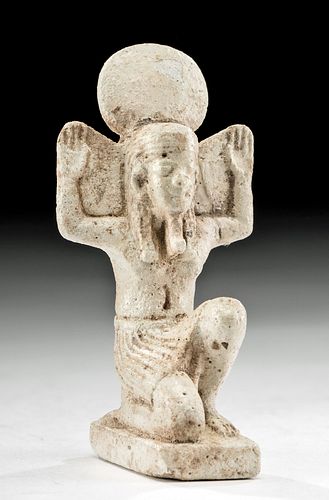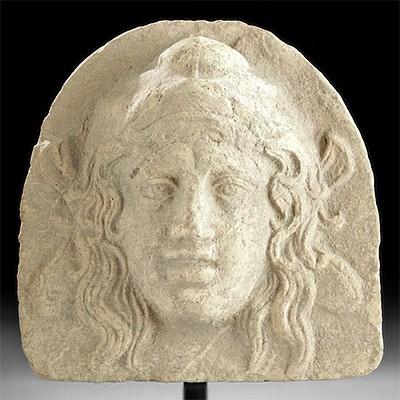Egyptian Glazed Faience Amulet of Shu
Lot 8a
About Seller
Artemis Fine Arts
686 S Taylor Ave, Ste 106
Louisville, CO 80027
United States
Selling antiquities, ancient and ethnographic art online since 1993, Artemis Gallery specializes in Classical Antiquities (Egyptian, Greek, Roman, Near Eastern), Asian, Pre-Columbian, African / Tribal / Oceanographic art. Our extensive inventory includes pottery, stone, metal, wood, glass and textil...Read more
Categories
Estimate:
$1,000 - $1,500
Absentee vs Live bid
Two ways to bid:
- Leave a max absentee bid and the platform will bid on your behalf up to your maximum bid during the live auction.
- Bid live during the auction and your bids will be submitted real-time to the auctioneer.
Bid Increments
| Price | Bid Increment |
|---|---|
| $0 | $25 |
| $300 | $50 |
| $1,000 | $100 |
| $2,000 | $250 |
| $5,000 | $500 |
| $10,000 | $1,000 |
| $20,000 | $2,500 |
| $50,000 | $5,000 |
| $100,000 | $10,000 |
| $200,000 | $20,000 |
About Auction
By Artemis Fine Arts
Feb 27, 2020
Set Reminder
2020-02-27 10:00:00
2020-02-27 10:00:00
America/New_York
Bidsquare
Bidsquare : VARIETY SALE | Antiquities & Ethnographic Art
https://www.bidsquare.com/auctions/artemis-gallery/variety-sale-antiquities-ethnographic-art-4920
Around the world & back in time - be amazed at the treasures you will find. Antiquities from Egypt, Greece, Italy and the Near East, Asian, Pre-Columbian, African / Tribal / Oceanic, Native American, Spanish Colonial, Russian Icons, Fine Art, much more! Artemis Fine Arts info@artemisgallery.com
Around the world & back in time - be amazed at the treasures you will find. Antiquities from Egypt, Greece, Italy and the Near East, Asian, Pre-Columbian, African / Tribal / Oceanic, Native American, Spanish Colonial, Russian Icons, Fine Art, much more! Artemis Fine Arts info@artemisgallery.com
- Lot Description
Egypt, Late Dynastic Period, 26th to 31st Dynasty, ca. 664 to 332 BCE. A finely detailed, mold-formed faience amulet of Shu covered in pale green glaze. Shu's standardized pose is defined by kneeling atop an integral rectangular plinth with his right knee down and left knee raised, wearing a pleated shendyt skirt, and an upright posture leaned against an integral dorsal pillar. His head bears almond-shaped eyes, cupped ears, a plaited false beard, and a broad nose, all beneath a pleated tripartite wig. Shu - the primordial deity personifying the air - holds his arms in a raised position that flank a sun disc, and this pose is highly symbolic of Shu lifting the skies and the heavens themselves. Shu is known as the father of Nut (goddess of the sky) and Geb (god of the earth) with his sister and wife Tefnut (goddess of moisture) and is associated with calmness, peace, and order. Size: 1.25" W x 2.6" H (3.2 cm x 6.6 cm)
For a stylistically similar example, please see The Metropolitan Museum of Art, accession number 04.2.372.
Another stylistically similar example, of a slightly taller size and with incredible detailing, hammered for GBP 56,250 ($73,351.69) at Christie's, London "Antiquities" auction (sale 17198, July 3, 2019, lot 21).
Provenance: private Chicago, Illinois, USA collection, acquired in 2019; ex-private London, UK collection, acquired in 2019; ex-private Canadian collection, acquired in 2011; ex-private American collection, formed between 1920 and 1932
All items legal to buy/sell under U.S. Statute covering cultural patrimony Code 2600, CHAPTER 14, and are guaranteed to be as described or your money back.
A Certificate of Authenticity will accompany all winning bids.
We ship worldwide and handle all shipping in-house for your convenience.
#151925Repair to left arm, with small chips and very light adhesive residue along break line. Minor abrasions and nicks to plinth, legs, body, arms, head, and sun disc, with fading and chipping to original glazing, minor softening to some finer details, and light encrustations and pitting. Nice earthen deposits throughout. Drilled hole beneath plinth likely for previous display stand.Condition
- Shipping Info
-
All shipping is handled in-house for your convenience. Your invoice from Artemis Gallery will include shipping calculation instructions. If in doubt, please inquire BEFORE bidding for estimated shipping costs for individual items.
-
- Buyer's Premium



 EUR
EUR CAD
CAD AUD
AUD GBP
GBP MXN
MXN HKD
HKD CNY
CNY MYR
MYR SEK
SEK SGD
SGD CHF
CHF THB
THB















